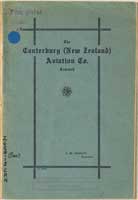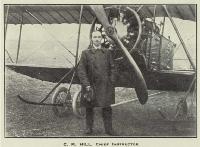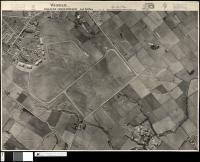
Wigram Air base was originally named Sockburn Aerodrome. This large airfield was home to the Canterbury (NZ) Aviation Company founded by Sir Henry Wigram and a group of supporters on 20 September 1916. Wigram was a successful and well-known businessman and mayor who had a passion for aviation. The base was used until 1995 for Royal New Zealand Air Force training and operations was closed to commercial air traffic in March 2009. After more than 90 years, the air base closed at the end of February 2009.
Pilot training
The private flying school trained pilots for World War I and entry into the Royal Flying Corps in Caudron biplanes. Two single-seaters were purchased for £1700 and one was fitted with dual controls. Before the planes were delivered two hangars and an administration building were constructed by trainee pilots.
 According to the digitised copy of the Canterbury (NZ) Aviation Company booklet, trainees paid a deposit of £5 and a fee of £100 to get themselves trained to Royal Aero Club certification level. Further instruction and aircraft hire was also available.
According to the digitised copy of the Canterbury (NZ) Aviation Company booklet, trainees paid a deposit of £5 and a fee of £100 to get themselves trained to Royal Aero Club certification level. Further instruction and aircraft hire was also available.
To gain a ‘ticket’ a pilot had to complete three tests:
- Three figure-of-eights,
- Taking off and landing on a mark.
- An altitude test and volplane, or glide.
The glide was particularly difficult in early aircraft. The person who granted the students the certificates, Lt Col Sleeman, watched from the ground as the tests were performed.
The first certificate went to Edwin Wilding, younger brother of Sir Anthony Wilding. Edwin later founded the still-operating Te Mania beef stud. The booklet also states that one unnamed student, who “gave promise of becoming a daring airman” was Māori. Only one failed to complete the training due to illness. Overall, Wigram wrote, the pilots represented “a fine type of New Zealand manhood”.
- Read more about the first 100 pilots trained at the school.
Something you won’t find mentioned in the school publication is the Canterbury Flying School song.
The school also pioneered commercial aviation in the region.
First flights, first death

The first flight was made by instructor Cecil M. Hill on 7 May 1917, and by 1919, 182 pilots had been trained – all but one left the country to join the Royal Air Force. Hill was killed on 1 February 1919 in a crash near Riccarton racecourse. Flights were used as drawcards to race meetings, and Hill flew over Riccarton at 3.11pm, coinciding with the running of the Lyttelton Plate. Apparently he tried a double loop and the port wing assembly collapsed under the strain.
- Read about the biplane and the crash.
Despite the fatality, expansion continued and ten planes had been built at Sockburn by the end of 1919, and efforts were made to establish regular commercial air services from Christchurch to various destinations.
Mail and passenger services
Some impressive feats were achieved, such as the first air crossing of Cook Strait in August 1920. Captain Euan Dickson of the Canterbury Aviation Company, with two passengers and some mail, left Christchurch in an Avro 504K biplane. Flying via Kaikoura and Blenheim they landed on the Trentham Racecourse in the Hutt Valley.
1920 was also the year Rodolph Wigley established New Zealand Aero Transport Company in Timaru. Wigley was educated at Christ’s College and also established the Mount Cook Motor Company and leased the Hermitage at Aoraki Mount Cook. Later he was instrumental in opening up the Central Otago tourist route.
A regular airmail service between Christchurch, Ashburton and Timaru was established in 1921, however government support for aviation services wavered and was limited to the release of surplus ex-war machines for sale. Unable to establish sufficient scheduled services, paying passengers had to be found on a more casual basis through joyrides and aerial displays. Costs were high and Wigram was forced to dip £10,000 further into his own pockets to keep his school afloat.
Another aviation pioneer and entrepreneur associated with Wigram was James Cuthbert (Bert) Mercer who founded Air Travel New Zealand which provided the first scheduled services for the West Coast from 1934. Mercer first served as a mechanic at Wigram in 1916. He then received flight training. Too old for overseas service he became an instructor. In 1928 he came the first pilot instructor for the newly formed Canterbury Aero Club.
Cathedral board game
In the 1960s Robert Moore was a trainee in the Royal New Zealand Air Force at Wigram airbase in Christchurch. He used the cathedral in the centre of the city as a landmark and some years later it inspired a 3D board game, Cathedral. Read about the history of this game and its prototypes.
Government takes over air base
Sir Henry Wigram kept the aviation school going until March 1923, when the government decided to take over the company and run the airbase under a military umbrella. The final purchase price was £31,012. In June 1923 the base was officially handed over and renamed Wigram Aerodrome. Wigram continued to support the base, gifting a further 81 acres of land in 1932. Wigram also donated £2500 to the Government for the purchase of an aeroplane – a Gloster Glebe fighter - for defence purposes.
Charles Kingsford-Smith (1897-1935) made the first Trans-Tasman flight from Sydney to Christchurch, arriving at Wigram on 10 September, 1928. The arrival was broadcast live on radio station 3YA by Allan Allardyce, who also called the city’s first rugby match broadcast in 1926.

The facilities at the base continued to expand as part of the public works programme, which used unemployed labour to develop the base through the 1920s and 30s. In 1937, Minister of Public Works Bob Semple, said that one of the major undertakings during the previous year had been the improvement of Wigram in line with the projected expansion of the Royal New Zealand Air Force.
After 1936 a change-over to regular public works conditions and procedure greatly accelerated the progress of the work
. This photograph shows the two new hangars and workshop in the foreground, with an older workshop, hangars and other buildings behind.
In 1953 Wigram was the scene of the worst RNZAF crash ever to take place in New Zealand. Two Royal New Zealand Air Force De Havilland Devons collided and seven men were killed.
Expansion and different uses
The aerodrome continued to expand after the Royal New Zealand Air Force took over the base. It was initially used for training pilots and aircraft mechanics, but two technical schools were also established to train photographers, aviation technicians, cooks, librarians and administrators. Accommodation and recreation facilities were built and roading was placed around the complex for service vehicles.
At one point the base consisted of:
- 427 buildings (including 159 houses and five flats)
- 22 miles (35.4km) of roads; 40 acres (16.187 Ha) of lawns and gardens
- playing fields and six tennis courts
- a 25-foot (7.6m) swimming pool
- a miniature rifle range
- a hobbies club, gymnasium
- a wet and dry canteen, a cinema, a dance hall
- a post office and a hospital
The base was also home to motor racing events such as the Lady Wigram Trophy, gliders, parachutists and tourist aircraft until its closure.
Sale of the site

A 1996 press release by Hon Denis Marshall, Minister of Lands, Sir Tipene O’Regan, Te Runanga o Ngāi Tahu and Cr Ron Wright, Christchurch City Council, announced that Ngāi Tahu had signed an agreement that gave them an option to buy the land. The statement proposed an agreement with the Christchurch City Council to lease most land for use as an airbase. Some land was to be developed by way of subdivision, while the Air Force Museum and a parcel of Wigram bequest land (the original Plumpton Park) went to the Crown. Education and recreation uses were also incorporated in the agreement.
The sale was reported by Land Information New Zealand in its July 1997 Landscan newsletter:
The sale of the former Wigram airbase by the Crown to Ngai Tahu has been successfully negotiated through Land Information New Zealand’s Crown Property Service, in consultation with the New Zealand Defence Force. The disposal of the approximately 275 hectare property on the outskirts of Christchurch sparked intense interest. Mike Jeffares, Manager of Crown Property Acquisitions/Disposals says the deal, due to be settled on 12 December has been completed to the satisfaction of all parties, including aviation interests, the Christchurch City Council and local residents. The negotiated price was $16.6 million plus GST.
Airfield closure, Wigram Skies
The site remained actively used for aviation until February 2009, when it was closed. A final airshow was held to mark the occasion. A subdivision called Wigram Skies is now on the site. Airmen involved in the 1953 crash at Wigram are commemorated in some of the street names of the development.
Air Force Museum
The Air Force Museum of New Zealand remains open to the public, with free admission, on land that Henry Wigram gifted to the government.
Select bibliography
- The history of Wigram 1917-1994, Therese Angelo, a paper given by the RNZAF Museum Research Officer at the 1994 Archives and Records Association conference, Wigram, 11 August 1994.
- A sense of closure, Philip Matthews, The Press, D1, Aug 2, 2008, viewed in the Proquest database, accessed 16 February 2009.
- Canterbury (NZ) Aviation Company Digitised resource, Christchurch City Libraries
- The Canterbury (NZ) Aviation Co.: the first hundred pilots Digitised resource, Christchurch City Libraries
- The Canterbury (NZ) Aviation Co. Ltd Biplane, from Aropaoanui The Story of a New Zealand Family, compiled by David Gregorie and accessed on the gregorie.com website February 2009.
- The song of the Canterbury Flying School from Aropaoanui The Story of a New Zealand Family, compiled by David Gregorie and accessed on the gregorie.com website February 2009.
- Wigram motor racing Murray McFadden
-
The Golden Era of New Zealand Motor Racing
 Graham Vercoe
Graham Vercoe - 50 years on track. A history of motorsport in New Zealand Sandy Myhre
- Wigram: a fading icon, Gerald Sandrey p 12-15 in Sport Flying, Spring 2008.
Search our catalogue
- Wigram Air Base
- New Zealand aviation history
- Photographs of aircraft in Christchurch
- Search Papers for Wigram-related items
